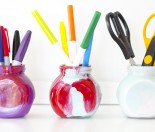Cardmaking is quite literally making cards, however there is more than one style of cardmaking and hundreds of different techniques. Originally card making gained popularity with the introduction of rubber stamps, but now card making involves various different art forms, many of which have been adapted from other craft areas.
Some card makers focus on a particular style, while others enjoy experimenting with a range of looks. There are plenty of ideas, tips, tricks, books, classes, and blogs available to help you make a great looking card, but there really is no right or wrong way.
The kids may have an upcoming event — perhaps birthday party, anniversary, Easter or Christmas — for which they can design and make cards or invitations, or they may wish to simply make cards to express friendship or just for fun. Card making can be simply a chance for you and your child to get creative.
Where do you learn Cardmaking?
There are specialist card making and paper craft stores in almost every town and city in New Zealand. Most, if not all paper craft shops offer card making classes, and some even have workshops specifically for children.
Each card making class is designed to teach you a specific style or technique, and more often, how to make a specific card. Ask your local paper craft store to see a sample of what card you will be making in each class, that way you can choose the workshops that suit.
Card making has also become a popular option for local high schools and community centres, and teenagers are usually welcome to attend. Most community education facilities put out their programmes on a term by term basis, so ask them to send you next term’s programme or watch your local paper around school holiday time.
What age can your child start Cardmaking?
Children start making cards as soon as they can put crayon to paper, and they never really stop! Children of any age can make cards in a style suitable for their age and skill level, and by the time they are teenagers, they will be able to grasp the most complex of card making techniques.
What equipment do you need for Cardmaking?
There are literally hundreds of different tools, templates and materials you can purchase for card making, however you don’t need them all! A good basic kit should include:
- A good craft knife and cutting mat. Craft knives give a much cleaner cut than scissors, and can get into spaces away from the card’s edge. Children may find a craft knife tricky to start with, but they get the hang of it fairly quickly. Make sure you talk about safety before they start.
- A metal ruler. It is important to use a metal ruler with your craft knife, as plastic or wooden rulers slowly get sliced away, and leave you with a less than straight edge to work with.
- A scoring blade for making nice folds in your card. There are lots of different scorers available, but any tool with a blunt end will do. Some card makers use a knitting needle or embossing stylus to score their cards.
- A selection of blank cards. A standard size card is A5 folded in half, and most paper craft stores sell A5 card specifically for this purpose. A4 size sheets (standard size photocopy paper) can simply be cut in half to create A5, or get creative and make cards in a size unique to you.To make sturdy cards you will need to use card that is at least 200g in weight. Usually the weight will be given on the packet, however if not, just rub the card between your fingers to check how strong it is.
- Adhesive. When it comes to adhesives, the sky is the limit. It really depends on what you like working with, and the types of materials you want to stick. Double sided tape is an excellent all round adhesive and it gives a good looking finish.
Where you go from here depends entirely on what style of card making you or your child want to do. If your child is just starting out, here are a few simple tools and materials they will enjoy:
- Craft Punches. Craft Punches work just like office hole punches, only they come in hundreds of different shapes and sizes. Children love punching and sticking, and you’ll be amazed at what they can create with just a few shapes.
- Stickers, stickers and more stickers. Peelcraft is a brand of stickers specifically for card makers and they include things like decorative borders and word sheets for every occasion. Their range is enormous, and the stickers are just the right size.
- Decorative Edge Scissors are like our old fashioned pinking shears, only they come in a whole range of designs. Children love being able to create a fancy edge with a single cut.
- Children love sparkly things, so glitter is always a good stand by. If you’re buying glitter specifically for card making, make sure you choose the extra fine variety or one already in an adhesive. Kindy Glitz, while a little more expensive than standard glitter glue, is a great brand with a tiny nozzle. It does not make nearly as much mess as the cheaper variety, and for parents, that counts for a lot!
How much does Cardmaking cost?
A standard card making class in NZ will cost between $15 -$20 and includes all the materials needed for the class. Some classes offered at high schools or community education facilities are part of an ongoing programme, and it is likely to cost you about $50 for a 6 week series. There will be material costs on top of this.
Some paper craft stores also offer “open tables”, which means people can use all the classroom equipment, but must either bring along their materials or purchase them from the store as they work. There is no instruction given at open tables, rather it is an opportunity for people to use tools and templates they may not have at home. Again, using an open table will vary in price, but it shouldn’t cost any more than $10.
A good craft knife will cost you between $10 – $15, but not all craft knives are created equal. Look for ones with a really sturdy shaft and strong well-attached blades. The Fiskars brand has a great knife with a rubber grip, which costs about $12 from paper craft stores. It’s bright purple and orange so you won’t loose it in a hurry either!
Craft mats vary in price from $8 – $30 depending on the size. There are a few brands available, but they are all of a very similar quality. Metal rulers also vary in price, but as long as it has a straight edge, it will do the job. You can often find metal rulers at emporium type shops for just a few dollars.
Rental Clubs are a great way to try out specific equipment, and it means you have access to lots of equipment without the huge financial outlay. Most paper craft stores have a rental club with a one-off membership fee of about $20 – $30, which acts as a bond. After that, members can hire equipment for as little as $2 per week.
Pre-cut cards cost around $5 for a packet of 20, or you can buy A4 size sheets for about 50c per sheet. It is slightly cheaper to buy A4 card in packets, however you end up with 40 cards exactly the same colour.
When it comes to craft punches you really do get what you pay for. You can pick up some great designs for about $4, but these are usually hard for children to use and can break very easily. You can expect to pay about $8 for a brand like Carl, which is good quality and has a money back guarantee.
How much time does it take to learn Cardmaking?
Card making classes are usually 1 ½ – 2 hours long, and in that time you will learn how to use a specific technique or make a specific card. There are literally hundreds of techniques, so you could make card making a lifetime lesson if you choose to.








I’m new to Palmy & I enjoy card making. Probably called an amateur but I would like to go to classes to meet people. Any suggestions please..